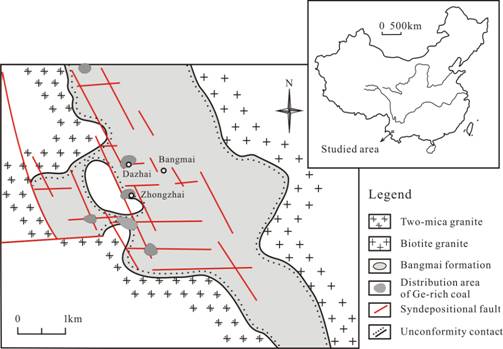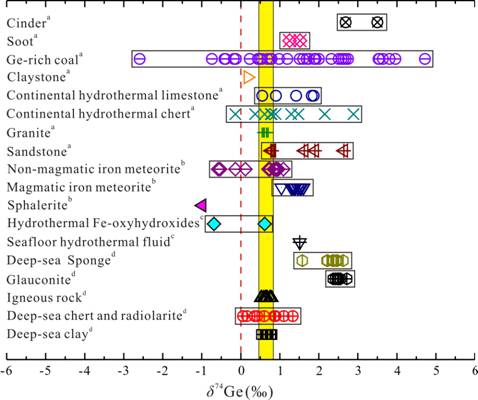 |
|
Fig.1 Simplified regional geological map of the Bamgmai Basin, Yunnan, Southwest China. (Image by IGCAS) |
 |
|
Fig.2 Summary of Ge isotopic composition of various samples (a) from the Lincang Ge deposit, as well as other Earth and planetary materials in literatures. (Image by IGCAS) |
Since Ge isotope is a new nontraditional isotope, the accumulated Ge isotope literatures are quite limited. The available researches mainly focused on two aspects: (1) the measurement of Ge isotopic compositions of geological and extraterrestrial materials, such as igneous rocks, marine sediments, seafloor hydrothermal fluids, hydrothermal Fe-oxyhydroxides, terrestrial high-temperature geothermal fluids, sphalerite, and iron meteorites; and (2) theoretical prediction of germanium isotope fractionation. These researches provided the preliminary foundation for the application of Ge isotopes. However, due to the limited quantities of analyzed samples and different standards used in actual measurement process, these studies still cannot meet the demands for the survey of natural geological and environmental end-reservoir of Ge isotope, and more researches are needed urgently to establish Ge isotope fractionation theory in natural complex water-rock interaction systems and to expand the geochemical tracing areas of Ge isotope.
From June 2010 to December 2010, with the support from the visiting scholar program of the Chinese Academy of Sciences, QI Huawen, Associated Professor of Institute of Geochmeistry, Chinese Academy of Sciences (IGCAS), went to Centre of Brest, French Research Institute for Exploitation of the Sea (IFREMER), and collaborated with Dr. Olivier Rouxel on carrying out the study of Ge isotopic compositions of different sediments (Ge-bearing coal, Ge-free coal, hydrothermal sedimentary chert and limestone, sandstone and claystone interlayered within the Ge-bearing coal seams), regional granite, and combustion products (coal ash, soot and cinder) of Ge-bearing coal, from the Lincang Germanium Deposit.
The results indicate that: (1) Ge-rich lignite samples and various samples from the Lincang Germanium Deposit, show large Ge isotopic fractionation; The Ge isotope fractionation of Ge-bearing coal samples is up to 7.31‰, and their δ74Ge values negatively correlate with Ge concentrations; Heavy Ge isotope (74Ge) tends to be concentrated in the middle of coal seams. (2) Simulative calculation approves that Rayleigh fractionation and mixing processes in an open system control the overall variations of Ge isotope fractionation of various samples; Ge-bearing coal and hydrothermal chert derives form a same source with δ74Ge values ranging from 1.84‰ to 1.97‰. (3) Low temperature ashing (600°C) cannot lead to obvious Ge isotope fractionation, which might be an alternative way to enhance Ge concentrations and to overcome matrix effects from high organic carbon content during analysis of organic-rich geological samples with low Ge concentrations; High temperature coal combustion also fractionates Ge isotopes, with light Ge isotope (70Ge) concentrated in soot and heavy isotope (70Ge) concentrated in cinder. The simultaneously enrichment of potential hazardous elements (i.e., Pb, Cd, Tl and As) and Ge in soot implies that Ge isotopes can be possibly used as tracers of the sources of anthropogenic heavy metal pollution in the environment.
The above results have been published in Chemcial Geology in July, 2011(Qi, H W, Rouxel, O, Hu, R Z, Bi, X W, Wen, H J., 2011. Germanium isotopic systematics in Ge-rich coal from the Lincang Ge deposit, Yunnan, Southwestern China. Chemical Geology 286, 252–265).
Both anonymous reviewers positively appraised the above research results. One reviewer stated that “this work is of great importance for our knowledge of Ge isotope geochemistry and that the data presented here are top quality and should be published”, and the other reviewer clearly specified that “In general I like this paper and I think that it will make a good contribution to the geochemical literature; in particular the Ge isotope literature, which is quite limited at this time”.